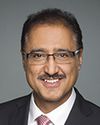I will.
First of all, thank you so much for inviting me to speak with you.
I would like to extend my congratulations to you, Chair, as well as to Luc Berthold and Linda Duncan on their recent elections as vice-chairs.
I have been asked to appear today to speak with you about my role in the development of a 10-year Canadian infrastructure plan and the delivery of a refocused new building Canada fund. I also want to talk about what my department is going to do to support the government's commitment to transparency and openness.
I'm joined today by my deputy minister, Mr. Tremblay, as well as associate deputy ministers Yazmine Laroche and Helena Borges, and assistant deputy minister Darlene Boileau.
I will begin by addressing the items on the main estimates.
Infrastructure Canada's total authorities for 2016-17 are $3.9 billion. Included in the department's main estimates is $2.1 billion through the gas tax fund, which is predictable funding for Canadian municipalities for their infrastructure priorities. There is also $1.6 billion in contribution funding available for provincial and territorial infrastructure projects. The remaining amount identified represents operating funding for Infrastructure Canada to administer and deliver these programs, and capital funding for the acquisition of land for the new Champlain Bridge corridor project and the Gordie Howe International Bridge.
Infrastructure Canada's expenditures match the pace at which funding partners build infrastructure projects and subsequently submit claims for eligible expenses. If recipients do not claim the expenses they forecast in any given fiscal year, Infrastructure Canada asks Parliament to re-profile program funds through future year appropriations to meet the cash flow needs of the recipients.
As you know, our government has committed to invest $60 billion in new infrastructure over the next 10 years. This funding does not appear in our 2016-17 estimates, but we are working with Minister Morneau as he develops the budget.
Now I will speak about the 10-year infrastructure plan and the refocusing of the new building Canada fund.
Everyone in this room knows that there are significant advantages to infrastructure investments, both in the short term and in the long term. Well-planned investments in infrastructure generate economic growth, create jobs, and leave a lasting legacy for Canadians.
But infrastructure is so much more than the structures themselves. It's more than concrete and water pipes, or roads and bridges, or buses and train tracks. Infrastructure is really about people. It is what connects Canadians to their communities and allows them to be active participants, both socially and economically.
Infrastructure is about parents sleeping in peace knowing that their children will have clean and safe water to drink. It is about a safe haven and a shelter for women fleeing domestic violence, and clean and safe housing for someone who has no other options. It is also about Canadians having decent, well-paid jobs that allow them to raise their families and give them a high quality of life. Infrastructure can do that.
Infrastructure is the foundation that shapes our communities, making them more livable and sustainable and providing the places where we want to live, work, and play. Our infrastructure investments must be made strategically, collaboratively, and with a long-term vision. They need to focus on projects that are not only shovel-ready but also shovel-worthy.
All orders of government have an equal role to play in building strong communities, and I'm working collaboratively with our government partners and indigenous communities, as well as our stakeholders and municipal association partners, to build the infrastructure this country needs. Collaboration will be key to our success.
I have already had extensive discussions with our provincial, territorial, and municipal partners and have met with mayors from across the country and representatives from indigenous communities. I have met numerous times with the Federation of Canadian Municipalities. I met last month with the Big City Mayors' Caucus, and I have met with other key stakeholders and associations, such as the Canadian Urban Transit Association. We are designing our new approach to infrastructure in collaboration with our partners. By working together, we will provide the long-term, dedicated, and predictable funding that will help build communities for the 21st century.
Let me talk about our plan.
We have committed to doubling infrastructure investment over the coming decade. This means $60 billion of additional investments over the next 10 years that will focus on three strategic areas: public transit, green infrastructure, and social infrastructure. In our desire to start supporting communities as quickly as possible, we have also committed to investing $10 billion of that money in the next two years.
We are also planning changes to the building Canada fund to make it more focused on strategic and trade-enabling infrastructure priorities, including roads, bridges, transportation corridors, ports, and border gateways. Also, we are looking at ways to make the application process more responsive and flexible to allow communities across the country to access funding more easily and rapidly.
Moving forward, we are faced with the challenge of getting infrastructure investments into our economy quickly while ensuring that we also act in a long-term and strategic way. Our work and investments over the next two years must lay the foundation for longer-term transformative change.
We know that infrastructure across the country is not in a state of good repair. The recent report card of the Federation of Canadian Municipalities reported that the condition of one-third of municipal infrastructure is between fair and very poor, and that at current reinvestment rates this infrastructure will continue to deteriorate. My consultations with partners reiterated that this critical aspect of infrastructure—recapitalization and repairs—demands attention. By focusing on the repairing of our existing infrastructure, we can fix what we have now instead of delaying and paying more to fix it later.
As we begin to invest in infrastructure, we also propose to make investments that can enhance municipal planning, asset management, and data collection capacity. This will help all orders of government make evidence-based decisions and put us on a more sustainable path.
By providing targeted infrastructure investment in social, green, and public transit projects and refocusing the new building Canada fund, we will be able to address the real needs of Canadian communities.
Finally, as I mentioned in my introduction, I want to speak about my department's commitment to transparency and openness. My department, like several others, has posted on our website the table of contents for the briefing binder I received when I was sworn in as minister. Anyone can reach out to the department and request to receive a copy of my briefing materials at no cost.
We have posted the signed project agreements for the work being done on the new Champlain Bridge. Last month, we posted a breakdown of the funding remaining in the new building Canada fund for each province and territory, which provides a clear picture of how much funding we have remaining to accelerate in the coming months and years, as we have committed to do. Also, I have been posting updates to our website that tell Canadians what I have been doing as Minister of Infrastructure and Communities, the partners I have met with, the meetings I have attended, and the projects I have visited.
As you know, our government has an ambitious plan to build communities that are sustainable and inclusive. By working in partnership with other orders of government and key stakeholders, we can develop and implement an evidence-based, strategic, and collaborative plan, one that will support us as we work to build the communities in which Canadians desire to live.
Thank you so much for having me here today.




